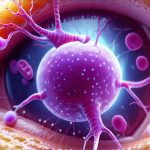Fatigue is one of the most pervasive complaints in modern life, often dismissed as simply “stress” or “not enough sleep.” While these factors certainly play a role, increasingly sophisticated research reveals a far more complex picture—one where the trillions of microorganisms living within us, collectively known as the microbiome, can exert a profound influence on our energy levels. For many individuals, fatigue isn’t necessarily linked to obvious digestive distress; it manifests subtly, as a chronic lack of motivation, persistent mental fogginess, or an overwhelming sense of exhaustion that doesn’t improve with rest. This disconnect between traditional symptoms and underlying causes often leads to misdiagnosis and ineffective treatment strategies, leaving people feeling lost and frustrated in their search for relief.
The emerging understanding of the gut-brain axis – the bidirectional communication network linking our digestive system and brain – is revolutionizing how we approach fatigue. It’s becoming clear that an imbalanced microbiome (dysbiosis) can disrupt this crucial connection, impacting neurotransmitter production, immune function, and even hormonal regulation, all contributing to feelings of tiredness and diminished vitality. This isn’t about having a “bad gut” necessarily; it’s about the complexity of these interactions and how seemingly minor imbalances can cascade into significant physiological effects. recognizing digestive symptoms is a crucial first step towards understanding the connection. Recognizing the potential role of your microbiome in fatigue, even without digestive issues, is the first step towards reclaiming your energy and wellbeing.
The Subtle Signs of Microbiome-Related Fatigue
Microbiome-related fatigue often doesn’t present as traditional “sick” symptoms. It’s far more insidious, creeping up gradually and mimicking other conditions, making it difficult to pinpoint the root cause. Unlike fatigue associated with viral infections or overexertion, this type of tiredness tends to be persistent and unresponsive to typical remedies like extra sleep. – A common descriptor is “flatline fatigue,” where individuals feel consistently drained regardless of activity level. This can manifest as:
* Difficulty concentrating (“brain fog”)
* Reduced motivation and apathy
* Increased irritability or mood swings
* Muscle weakness not explained by exertion
* Sleep disturbances, even with adequate sleep duration
– It’s important to distinguish this from the acute fatigue experienced after strenuous activity or during illness. Microbiome-related fatigue is chronic, lasting for weeks, months, or even years without a clear resolution. why digestive tests matter can help rule out other causes and pinpoint imbalances.
The connection between the microbiome and these seemingly unrelated symptoms lies in its influence on several key physiological processes. For instance, the gut microbiome plays a vital role in synthesizing essential vitamins (like B vitamins and vitamin D) that are crucial for energy production. Dysbiosis can impair this synthesis leading to deficiencies that exacerbate fatigue. Furthermore, an imbalanced microbiome can trigger low-grade chronic inflammation, which is known to drain energy reserves and contribute to cognitive dysfunction. The gut also produces a significant amount of neurotransmitters like serotonin (the “happy hormone”) and dopamine (involved in motivation and reward), and the composition of your microbiome directly impacts their production. A disrupted microbiome can therefore affect mood and drive, contributing to feelings of fatigue and apathy.
Finally, consider the impact on immune function. Approximately 70-80% of our immune system resides within the gut, and a healthy microbiome is essential for proper immune regulation. Dysbiosis can lead to immune dysregulation, resulting in chronic inflammation and an overactive or underactive immune response. Both scenarios require significant energy expenditure from the body, further contributing to fatigue. Recognizing these subtle signs – even in the absence of digestive symptoms – is crucial for exploring the potential role of your microbiome. recognizing digestive symptoms can also help rule out other causes, like anxiety.
Beyond Digestion: Where Else Does the Microbiome Impact Energy?
While we often associate the gut with digestion, its influence extends far beyond simply breaking down food. The microbiome’s impact on energy production and overall wellbeing is multifaceted, reaching into areas like neurological function, hormonal balance, and immune regulation. This systemic effect explains why microbiome-related fatigue can manifest in diverse ways, even without gastrointestinal complaints. – It’s a whole-body system interacting with another whole-body system – the human body!
One key area of impact is mitochondrial function. Mitochondria are the “powerhouses” of our cells, responsible for converting nutrients into usable energy (ATP). The gut microbiome influences mitochondrial health through various mechanisms. For example, certain bacterial metabolites can directly enhance mitochondrial biogenesis (the creation of new mitochondria) and improve their efficiency. Conversely, dysbiosis and chronic inflammation can impair mitochondrial function, leading to reduced energy production and increased fatigue. This link explains why some individuals with seemingly healthy diets and lifestyles still struggle with persistent tiredness.
Furthermore, the microbiome plays a surprising role in hormonal regulation. It impacts the hypothalamic-pituitary-adrenal (HPA) axis – our body’s primary stress response system – influencing cortisol levels and overall hormonal balance. Chronic dysbiosis can disrupt HPA axis function, leading to adrenal fatigue or dysfunction. This disruption can manifest as persistent tiredness, difficulty coping with stress, and impaired sleep quality. The microbiome also influences thyroid hormone conversion, which is critical for energy metabolism. An imbalanced gut can interfere with the conversion of T4 (inactive thyroid hormone) into T3 (active thyroid hormone), leading to hypothyroidism-like symptoms including fatigue and weight gain. how to rotate foods can help reduce inflammation.
Identifying Potential Microbiome Imbalances
Pinpointing a microbiome imbalance isn’t always straightforward, as there’s no single “test” that definitively diagnoses it. However, several assessment methods can provide valuable insights.
* Comprehensive Stool Analysis: This is currently the gold standard for evaluating gut microbial composition and identifying potential imbalances. These tests analyze bacterial diversity, identify specific pathogens, and assess markers of inflammation and digestive function. It’s important to note that these tests are best interpreted by a healthcare professional who understands microbiome health.
* Organic Acids Test (OAT): The OAT assesses metabolic pathways in the gut, providing clues about microbial activity and nutrient deficiencies. This test can help identify imbalances related to yeast overgrowth or bacterial dysbiosis.
* Symptom Assessment: A thorough assessment of your symptoms, lifestyle factors (diet, stress levels, sleep quality), and medical history can provide valuable clues. Look for patterns that suggest a potential microbiome connection – persistent fatigue, brain fog, mood swings, food sensitivities, and difficulty coping with stress are all red flags.
It’s crucial to remember that stool tests provide a snapshot in time. The microbiome is dynamic and constantly changing based on various factors. Therefore, multiple assessments may be necessary to get an accurate picture of your gut health. Also, while testing can be helpful, it shouldn’t be the sole basis for treatment decisions. A holistic approach that considers your individual symptoms, lifestyle, and medical history is essential. – how to track digestive symptoms can help identify patterns.
Dietary Strategies for Microbiome Support
Diet plays a pivotal role in shaping the composition of your microbiome and influencing your energy levels. – Focusing on whole, unprocessed foods is the foundation of any microbiome-supporting diet.
* Increase Fiber Intake: Fiber serves as food for beneficial gut bacteria, promoting their growth and diversity. Include plenty of fruits, vegetables, legumes, and whole grains in your diet.
* Incorporate Fermented Foods: Fermented foods like yogurt (with live cultures), kefir, sauerkraut, kimchi, and kombucha are rich in probiotics – live microorganisms that can colonize the gut and improve microbial balance.
* Limit Sugar and Processed Foods: Excessive sugar intake and processed foods feed harmful bacteria, contributing to dysbiosis. Reduce your consumption of sugary drinks, refined carbohydrates, and ultra-processed snacks.
Beyond specific food choices, consider incorporating prebiotics – non-digestible fibers that selectively nourish beneficial gut bacteria. Prebiotic-rich foods include garlic, onions, leeks, asparagus, bananas, and oats. It’s also essential to stay hydrated, as water is crucial for maintaining a healthy digestive system and supporting microbial activity. Gradual dietary changes are typically more effective than drastic restrictions. Rapid shifts can disrupt the microbiome further, leading to temporary discomfort.
Lifestyle Factors Beyond Diet
While diet is foundational, several other lifestyle factors significantly impact microbiome health and energy levels. – Prioritizing stress management is crucial, as chronic stress disrupts gut microbial balance and impairs immune function. Techniques like meditation, yoga, deep breathing exercises, or spending time in nature can help reduce cortisol levels and promote a healthier gut-brain connection.
Adequate sleep is also essential for microbiome health. Sleep deprivation disrupts the circadian rhythm, impacting gut microbial composition and increasing inflammation. Aim for 7-9 hours of quality sleep each night. Finally, regular moderate exercise has been shown to improve gut microbial diversity and enhance immune function. However, avoid overtraining, as excessive exercise can suppress immune function and exacerbate fatigue. – how to travel without triggering digestive symptoms is important even when on the go.
Ultimately, restoring microbiome balance is a journey that requires patience, consistency, and a holistic approach. It’s about creating an internal environment where beneficial bacteria thrive, supporting optimal energy production, and reclaiming your wellbeing.


















